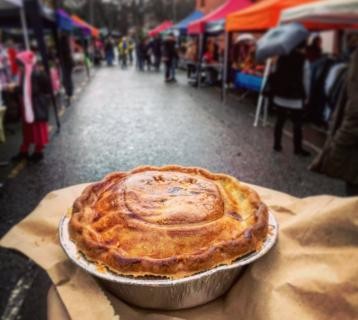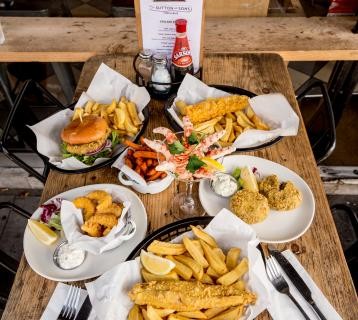Food lovers can find a bounty of delicious, traditional dishes without a short-haul flight by visiting one of our own (often underrated) English foodie capitals and trying a signature dish.

Everybody knows that England is the home of pie and mash and spotted dick. But ask a friend their thoughts on wet nellies, godcakes or clangers, and they’re likely to look at look at you as though you’re one sandwich short of a picnic.
Yet, these peculiarly named dishes are a vital and delicious part of our country’s food history: unique regional foods, often originating from a minuscule village or family shop many centuries ago, yet still with diehard fans. And with a ticket on London Northwestern Railway, which runs services to and from London, Birmingham, Liverpool, Coventry, Bedford and more, you can try them all – just as long as you’re prepared to eat a lot of carbs.
These storied local dishes, you see, hark back to a time when the carb was king. If it was deep-fried, swaddled in pastry, or stuffed with potatoes, our ancestors were there faster than Nigella Lawson on a midnight fridge raid. In Liverpool, the signature dish is scouse, a rich meat and potato stew that probably came to the port city via Germany or Scandinavia in the 18th or 19th century. Cheap-and-cheerful cafe Maggie May’s is a city favourite; its scouse is so popular that after scoffing a bowl for lunch, you can buy a pouch to take home for dinner. At beloved community bakery Homebaked, just opposite Anfield stadium, it’s a match-day ritual to tuck into a scouse pie before kick-off. And if you’re more a fine-dining connoisseur, head to elegant restaurant Roski, where MasterChef winner Anton Piotrowski sometimes serves a gourmet twist on the classic, including slow-cooked brisket, “parsley powder” and beer-marinated onions. Sailor rations this is not.

Over in Bedford, it’s all about the clanger – and no, that’s not those pink knitted mice who live on the moon. The Bedfordshire clanger is the county’s answer to the Cornish pasty: a sort of savoury jam roly-poly, made with suet pastry and stuffed with beef and veg. In the days before Pret, agricultural workers would take a homemade clanger for lunch – if they were very lucky, they’d get an “‘alf and ‘alf’” (savoury at one end, and a sweet filling such as apple at the other). Today, the clanger is having a renaissance at family-run Gunns Bakery, whose three branches offer trendy new fillings, including rhubarb and custard, sage and cider pork and curried vegetables. Apparently even Jamie Oliver is a fan.
Many treasured regional dishes are the product of immigration. It’s a foodie crime to visit Birmingham without tucking into a balti, the sizzling hot curry created by Pakistani chefs in the 1970s to appeal to their English customers. Pay homage in the Balti Triangle, a curry-house cornucopia where you’ll find gems such as Adil’s: a no-frills restaurant that claims to have invented the balti, and where the vast menu of baltis ranges from the hearty sheesh dall, with lamb meatballs and lentils, to creamy makhan with chicken, butter and almonds.
Just a five-minute walk away (or a wobble, if you’ve been on the Cobra) is Al Frash, where you can customise baltis to your exact taste, on a sliding scale of heat levels. If you’re a spice fiend, try the fahl, the next step up from a vindaloo. Just make sure you order a nice mango lassi to combat the incoming inferno.
You’d never guess that our love affair with curries was behind a rather less exotic treat: the Staffordshire oatcake. Some historians claim the oat-y pancake was inspired by the chapatis local soldiers tried in India in the days of the Raj. Whether or not that’s true, oatcakes still sell like, well, hot cakes, especially in Stoke-on-Trent. Pop into High Lane or London Road Oatcakes to try the traditional version, or keep your eyes peeled for more unusual twists on the delicacy. The Bull’s Head pub in nearby Alton is famous for its velvety oatcake ice-cream, rippled with caramel and cinnamon.

If you’ve got a soft spot for fish and chips, you might be tempted to head for the sea. But to track down its true roots, you’re better off in London. Fish and chips, too, is an immigrant story; it’s thought that Jews fleeing persecution in Europe brought over the tradition of frying fish in flour, while Huguenot refugees introduced crunchy fried potatoes. Faced with two such deliciously greasy products, it was decided that the only sensible action was to put them together. Today, there’s the perfect chippy for everyone. Traditionalists love the Rock & Sole Plaice, the oldest in the capital, which dates back to 1871 and even survived a bomb blast during the blitz. Meanwhile, cool young things hang out at Sutton & Sons in Hackney, the capital’s first dedicated “vegan chippy”, where they can blissfully tuck into chips, mushy peas and “tofish” (that’s tofu fish, didn’t you know?).
When it comes to sweet treats, Liverpudlians can’t resist the charms of a wet nelly, a bread pudding that lends its name to James Bond’s submarine in The Spy Who Loved Me. Spend a day wandering around gorgeous National Trust property Speke Hall, then tuck into a slice at the Home Farm restaurant, best served as an even wetter nelly with lashings of custard.
If you’re the person in your family who demolishes most of the mince pies at Christmas, then you’ll love Coventry godcakes, pastry triangles stuffed with mincemeat and spices, which were traditionally made by godparents to give to their godchildren at New Year. The godcake came close to extinction but, like the Spice Girls and denim skirts, it’s had a comeback. Coventry baker Leigh Waite has led the holy charge, supplying her version of the fruity treat for Esquires coffee house, attached to the city’s transport museum. Thankfully, godchildren are not compulsory for purchase.
But for a really unique bake, you’ll have to book a train ticket for August bank holiday. Every year in the picturesque village of Long Buckby in Northamptonshire, a traditional village fair or “feast” is held. The star attraction is the competition to find the best Feast Pudn’ – a sort of cross between fruit cake and Christmas pudding that dates back to medieval times. Make friends with a villager, and they might just sneak you a slice to enjoy on your journey home.


